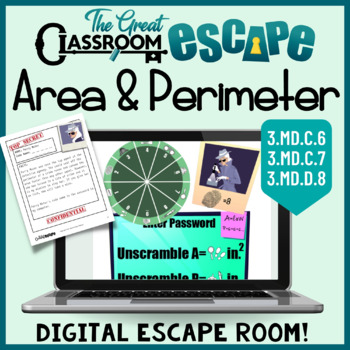Finding Area and Perimeter 3rd Grade Math Activity Fun Digital Escape Room
- PDF
- Google Apps™
- Easel Activity

What educators are saying
Also included in
- The Great Classroom Escape's bundle of 3rd grade math escape rooms addresses many third grade math standards. These easy to implement, self-checking 3rd grade math activities and games are great worksheet alternatives and encourage active learning. Escape rooms are a great way to review for end-of-yPrice $20.79Original Price $25.99Save $5.20
Description
Finding area and perimeter will help your third graders find the missing detective in this fun and engaging digital escape room. Based on 3rd grade measurement and data standards, this low-prep activity is great for practice, review, and enrichment. Students find the area and perimeter of rectangles with whole number side lengths, recognize area as additive as they decompose shapes, find missing side lengths given a perimeter, and use unit squares to solve puzzles.
This online escape room activity is easy to implement. The breakout process is fully automated by a Google Form™, so there are no answers to check or clues to hide. Optional printable versions of the puzzles are available to supplement the digital escape room. These allow students to show their work and to make the escape room even more engaging. Google™ accounts are not required; anybody with an internet connected device can complete this 3rd grade math escape room.
Digital escape rooms are a fun and engaging way to practice and review math skills. While this activity can be completed by students individually, it is recommended to have students work in small groups or pairs to encourage collaboration. It will be important for students to read clues carefully. Escape rooms are meant to be challenging, so don't be afraid to let students struggle and puzzle through the problems!
Math skills required to solve the puzzles:
- Measure data by counting unit squares 3.MD.C.6
- Calculate the area of rectangles with single-digit whole number side lengths by using multiplication 3.MD.C.7
- Decompose figures into rectangles to calculate area (recognizing that area is additive). *Printable versions of this puzzle are available both with and without unit squares to allow for differentiation. 3.MD.D.7d
- Find the perimeter of shapes 3.MD.D.8
- Find missing side lengths when given a perimeter 3.MD.D.8
- Solve word problems involving area and perimeter 3.MD.C.7c, 3.MD.D.8
- One puzzle provides the opportunity for students to use the distributive property when finding the area of a rectangle. 3.MD.C.7c
What's included in the PDF?
- Quickstart guide with link to escape room
- Optional link for Google Drive™ users to create a copy of the form to save to their own drives in order to view student results.
- Optional (but recommended) printable student pages to work out puzzles on
- Optional cipher disk to make the activity more interactive
- Detailed answer key & teacher tips
- Success signs to snap photos with after completing the activity (optional)
FAQ
- Do students need to have Gmail™ accounts? NO! Anyone with internet access and a tablet, computer, or even phone can complete the breakout.
- How long will this take? That is the hardest question as the answer varies depending on each classroom, student, or group. Most students will be able to complete this activity in under 45 minutes. You can allow 60 minutes to be safe. The form will only save data if students are signed into Google accounts, so if you are worried about your students not finishing on time, simply have them write their answers on scratch paper. They can then come back and quickly re-enter their answers and pick up where they left off. Some students with a firm grasp on the concepts covered in this escape room will be able to complete the puzzles very quickly (20-30 minutes), others will take longer.
- Can this be used for remote learning? Yes! This product is designed to be able to be completed completely online and can be done in-person, for distance learning, or hybrid models. Students will need a device and internet connection.
- Will students have to search the web to figure out the puzzles? NO! All of the information needed will be provided in the Google Form™. The math in this activity is all standards-based.
Escape rooms are a great way to provide extra practice for students, review for tests, or provide enrichment.







